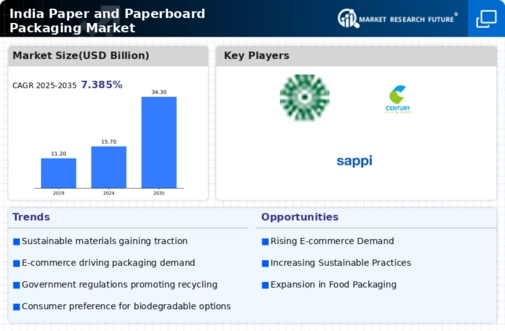Increase in Food and Beverage Sector
The food and beverage sector in India is experiencing robust growth, which is positively influencing the paper paperboard-packaging market. With the rise in disposable income and changing consumer lifestyles, there is a growing demand for packaged food products. In 2025, the food and beverage industry is expected to reach a market size of $100 billion, necessitating effective packaging solutions that ensure product safety and extend shelf life. This trend is prompting manufacturers to develop innovative packaging designs that cater to the specific needs of food products, such as moisture resistance and tamper-proof features. Consequently, the paper paperboard-packaging market is likely to thrive as it adapts to the evolving requirements of the food and beverage sector.
Growth of E-Commerce and Online Retail
The rapid expansion of e-commerce and online retail in India is significantly impacting the paper paperboard-packaging market. As more consumers turn to online shopping, the need for effective packaging solutions that ensure product safety during transit has become paramount. In 2025, the e-commerce sector is projected to reach a valuation of $200 billion, leading to an increased demand for packaging materials that are both durable and lightweight. This trend is prompting manufacturers to innovate in packaging design, focusing on materials that can withstand shipping conditions while being cost-effective. The paper paperboard-packaging market is thus positioned to benefit from this growth, as companies seek reliable packaging solutions to meet the demands of the online retail landscape.
Rising Demand for Eco-Friendly Packaging
The increasing awareness regarding environmental sustainability is driving the demand for eco-friendly packaging solutions in the paper paperboard-packaging market. Consumers in India are becoming more conscious of their purchasing decisions, favoring products that utilize sustainable materials. This shift is reflected in the market, where the demand for recyclable and biodegradable packaging options has surged. In 2025, it is estimated that the eco-friendly segment could account for over 30% of the total packaging market. Companies are responding by innovating their product lines to include sustainable options, thereby enhancing their market competitiveness. The paper paperboard-packaging market is likely to see continued growth as businesses align their strategies with consumer preferences for environmentally responsible products.
Technological Advancements in Packaging Solutions
Technological advancements are playing a crucial role in shaping the paper paperboard-packaging market. Innovations in printing, design, and production processes are enabling manufacturers to create more efficient and visually appealing packaging solutions. For instance, the introduction of digital printing technology allows for customization at lower costs, catering to the diverse needs of consumers. Additionally, automation in production lines is enhancing efficiency, reducing waste, and lowering operational costs. As these technologies continue to evolve, they are likely to drive growth in the paper paperboard-packaging market, allowing companies to offer high-quality products that meet the demands of modern consumers.
Government Initiatives Promoting Sustainable Practices
Government initiatives aimed at promoting sustainable practices are significantly influencing the paper paperboard-packaging market. Policies encouraging the use of recyclable materials and reducing plastic waste are driving manufacturers to adopt eco-friendly packaging solutions. In 2025, various state governments are expected to implement stricter regulations on plastic usage, further pushing the demand for paper-based packaging. These initiatives not only support environmental goals but also create opportunities for businesses to innovate and differentiate their products in the market. As a result, the paper paperboard-packaging market is likely to see a shift towards more sustainable practices, aligning with government objectives and consumer expectations.














Leave a Comment